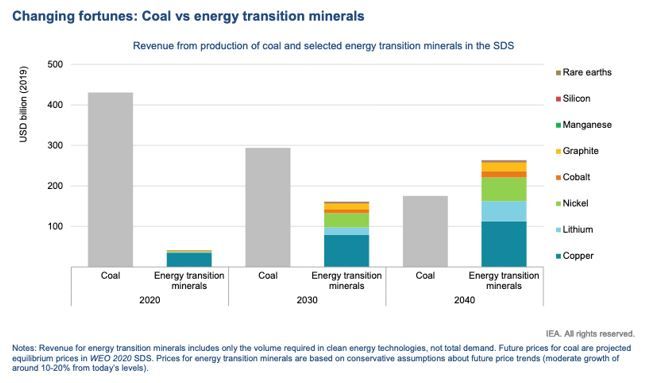
To create a clean, green future powered by renewable energy, mining—and mining jobs—is going to be as important as ever.
New data shows just how important the mining industry is going to be if Australia and the world are going to successfully switch to a “clean energy future”.
While coal, oil and gas might be on the way out as energy sources, someone still needs to mine the raw materials and elements needed not only to power our homes, businesses and economies into the future, but to build the equipment, tools and infrastructure needed to create and distribute that power.
Mining will be critical to clean energy transition
Here’s a fascinating and revealing graphic from the International Energy Agency’s recent The Role of Critical Minerals in Clean Energy Transitions report. It highlights two key areas where we’re already seeing a lot of progress in developing “clean energy alternatives” to traditional fossil fuel use—transportation and power generation.

The chart shows huge volumes of copper will be needed to build the electric cars and generate the green energy that are set to become a part of our daily lives. Similarly, we’re going to need a lot of lithium, zinc, nickel, manganese, graphite and rare-earths.
Australia in a good position in terms of mineral deposits
If you’ve been around the mining industry, or at least been paying attention to it, for any length of time, you’ll know that Australia and particularly Western Australia are very rich in many of the minerals listed in the chart above. That chart, by the way, doesn’t even mention iron ore—the essential element of steel—which is Australia’s top export and will presumably still be needed to build car bodies, elements of wind turbines, and so on.
What’s more, as the chart above shows, greener options require a lot more raw minerals per unit (for each car, for each turbine, etc.) than conventional technology. Each electric car (EV), for example, uses six times more minerals than a conventional car.
What does that look like in terms of mining activity?
“In a scenario that meets the Paris Agreement goals, clean energy technologies’ share of total demand rises significantly over the next two decades to over 40% for copper and rare-earth elements, 60-70% for nickel and cobalt, and almost 90% for lithium,” the International Energy Agency’s report said.
“EVs and battery storage have already displaced consumer electronics to become the largest consumer of lithium and are set to take over from stainless steel as the largest end user of nickel by 2040.”
In fact, according to the report, mineral demand for clean energy technologies is set to rise by at least four times by 2040 if countries are going to meet their climate goals. Here’s how the report forecasts that transition will look:

A clean, green future and your mining career
For those who work in mining or want a long and healthy career in the industry, the news from the report is good. While mining sometimes cops criticism from those concerned about its environmental impacts, the fact is mining has a critical role to play in ensuring a clean, green future for our planet. And because of that, there will be plenty of high-quality jobs in Australia’s mining industry long into the future.
Make sure to register your details with us to ensure you’re considered for upcoming opportunities that match your skill set.